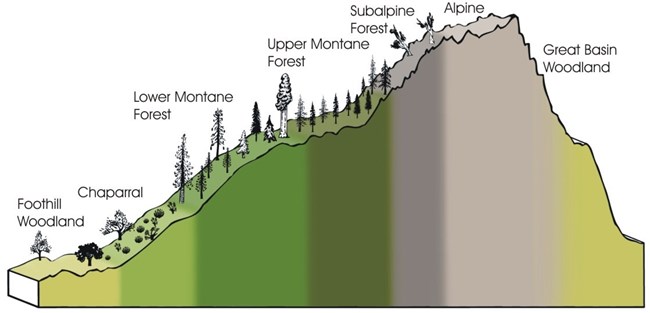
NPS / Talia Chorover
Mountain ecosystems face numerous threats. The most significant include air pollution, climate change, invasive species, altered fire regimes, and habitat fragmentation outside of parks.

Illustration by: Justin Hofman and Meryl Goldin Rose
How Do Habitats Vary on Mountains?
One example of a mountain elevation gradient is illustrated by this graphic of vegetation zones across the steep western slope of the Sierra Nevada, in Sequoia National Park. Species diversity typically decreases from low to high elevations, and across latitudes from the Equator toward each pole. Temperature and moisture availability vary across elevations and latitudes, and are important drivers of where plants and animals can live.
Exploring Mountain Life and Habitats
People who visit national parks are often drawn to the solitude and natural environments that parks offer. Viewing wildlife (from safe distances) can be a memorable highlight for park visitors--whether watching a bear foraging in a forest, seeing a hawk soaring overhead, or hearing frogs chorusing in a wetland. Many also time their visits to see the reds and golds of fall foliage or the many-colored wildflowers blooming in mountain meadows. Visit the links below to explore the variety of plants, animals, and habitats of mountain parks.Learning about Mountain Life
-
 Animals
AnimalsLearn more about animals living in mountain habitats.
-
 Plant Life
Plant LifeExplore mountain plant life including conifer and deciduous forests, and alpine and arctic tundra.
-
 Wetlands and Meadows
Wetlands and MeadowsLearn about wetlands and the diversity of life they support.
Last updated: December 3, 2020
